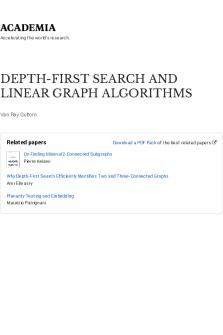DEPTH-FIRST SEARCH AND LINEAR GRAPH ALGORITHMS PDF

| Title | DEPTH-FIRST SEARCH AND LINEAR GRAPH ALGORITHMS |
|---|---|
| Author | Van Ray Gultom |
| Pages | 16 |
| File Size | 1.9 MB |
| File Type | |
| Total Downloads | 37 |
| Total Views | 394 |
Summary
SIAM J. COMPUT. Vol. 1, No. 2, June 1972 DEPTH-FIRST SEARCH AND LINEAR GRAPH ALGORITHMS* ROBERT TARJAN" Abstract. The value of depth-first search or "bacltracking" as a technique for solving problems is illustrated by two examples. An improved version of an algorithm for finding the s...
Description
Accelerat ing t he world's research.
DEPTH-FIRST SEARCH AND LINEAR GRAPH ALGORITHMS Van Ray Gultom
Related papers
Download a PDF Pack of t he best relat ed papers
On Finding Minimal 2-Connect ed Subgraphs Pierre Kelsen Why Dept h-First Search Efficient ly Ident ifies T wo and T hree-Connect ed Graphs Amr Elmasry Planarit y Test ing and Embedding Maurizio Pat rignani
SIAM J. COMPUT. Vol. 1, No. 2, June 1972
DEPTH-FIRST SEARCH AND LINEAR GRAPH ALGORITHMS* ROBERT
TARJAN"
Abstract. The value of depth-first search or "bacltracking" as a technique for solving problems is illustrated by two examples. An improved version of an algorithm for finding the strongly connected components of a directed graph and ar algorithm for finding the biconnected components of an undirect graph are presented. The space and time requirements of both algorithms are bounded by k 1V + k2E d- k for some constants kl, k2, and k a, where Vis the number of vertices and E is the number of edges of the graph being examined.
Key words. Algorithm, backtracking, biconnectivity, connectivity, depth-first, graph, search, spanning tree, strong-connectivity.
1. Introduction. Consider a graph G, consisting of a set of vertices U and a set of edges g. The graph may either be directed (the edges are ordered pairs (v, w) of vertices; v is the tail and w is the head of the edge) or undirected (the edges are unordered pairs of vertices, also represented as (v, w)). Graphs form a suitable
abstraction for problems in many areas; chemistry, electrical engineering, and sociology, for example. Thus it is important to have the most economical algorithms for answering graph-theoretical questions. In studying graph algorithms we cannot avoid at least a few definitions. These definitions are more-or-less standard in the literature. (See Harary [3], for instance.) If G (, g) is a graph, a path p’v w in G is a sequence of vertices and edges leading from v to w. A path is simple if all its vertices are distinct. A path v is called a closed path. A closed path p’v v is a cycle if all its edges are p’v distinct and the only vertex to occur twice in p is v, which occurs exactly twice. Two cycles which are cyclic permutations of each other are considered to be the same cycle. The undirected version of a directed graph is the graph formed by converting each edge of the directed graph into an undirected edge and removing duplicate edges. An undirected graph is connected if there is a path between every pair of vertices. A (directed rooted) tree T is a directed graph whose undirected version is connected, having one vertex which is the head of no edges (called the root), and such that all vertices except the root are the head of exactly one edge. The relation "(v, w) is an edge of T" is denoted by v- w. The relation "There is a path from v to w in T" is denoted by v w. If v w, v is the father of w and w is a son of v. If v w, v is an ancestor of w and w is a descendant of v. Every vertex is an ancestor and a descendant of itself. If v is a vertex in a tree T, T is the subtree of T having as vertices all the descendants of v in T. If G is a directed graph, a tree T is a spanning tree of G if T is a subgraph of G and T contains all the vertices of G. If R and S are binary relations, R* is the transitive closure of R, R-1 is the inverse of R, and
-
RS
{(u, w)lZlv((u, v) R & (v, w) e S)}.
* Received by the editors August 30, 1971, and in revised form March 9, 1972. Department of Computer Science, Cornell University, Ithaca, New York 14850. This research was supported by the Hertz Foundation and the National Science Foundation under Grant GJ-992.
"
146
DEPTH-FIRST SEARCH
147
Ifff,
f, are functions of x, x,, we sayfis O(f, f,) if x,)l + x,)l If(x,,..., x,)l...
Similar Free PDFs
Popular Institutions
- Tinajero National High School - Annex
- Politeknik Caltex Riau
- Yokohama City University
- SGT University
- University of Al-Qadisiyah
- Divine Word College of Vigan
- Techniek College Rotterdam
- Universidade de Santiago
- Universiti Teknologi MARA Cawangan Johor Kampus Pasir Gudang
- Poltekkes Kemenkes Yogyakarta
- Baguio City National High School
- Colegio san marcos
- preparatoria uno
- Centro de Bachillerato Tecnológico Industrial y de Servicios No. 107
- Dalian Maritime University
- Quang Trung Secondary School
- Colegio Tecnológico en Informática
- Corporación Regional de Educación Superior
- Grupo CEDVA
- Dar Al Uloom University
- Centro de Estudios Preuniversitarios de la Universidad Nacional de Ingeniería
- 上智大学
- Aakash International School, Nuna Majara
- San Felipe Neri Catholic School
- Kang Chiao International School - New Taipei City
- Misamis Occidental National High School
- Institución Educativa Escuela Normal Juan Ladrilleros
- Kolehiyo ng Pantukan
- Batanes State College
- Instituto Continental
- Sekolah Menengah Kejuruan Kesehatan Kaltara (Tarakan)
- Colegio de La Inmaculada Concepcion - Cebu


